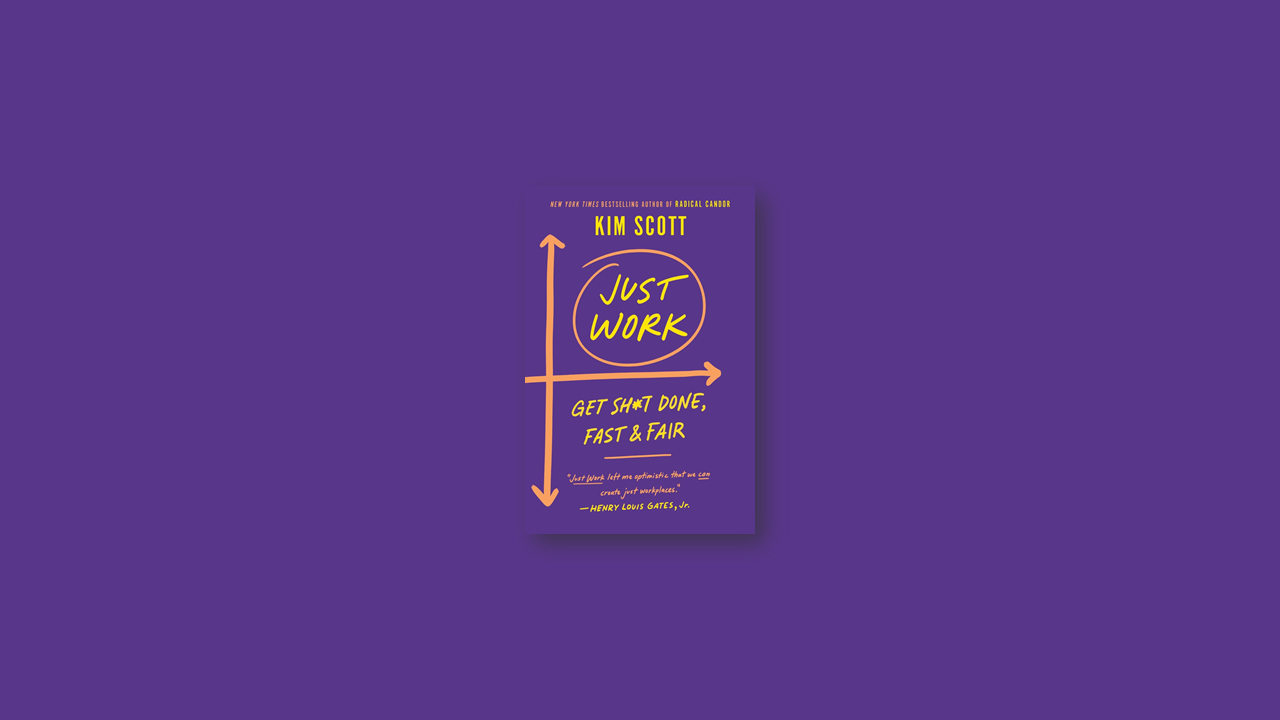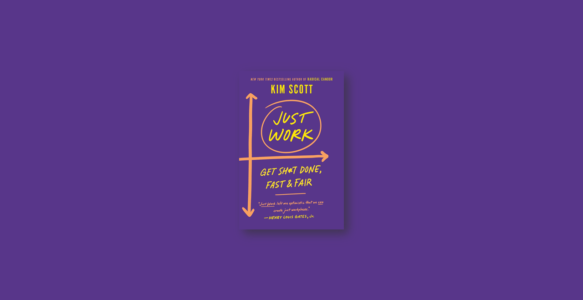Kindle | Hardcover | Audiobook
Justice Is By Design
Have you ever worked at a company where you feel everything is right? Your boss is fair and treats you well. Your colleagues are helpful and respectful. The system allows you to do your best work. There’s little to no bias, prejudice, bullying, discrimination and harassment. Perhaps you feel this experience because you’ve been there. Or perhaps you have never had this experience. Even then, you can imagine what it feels like.
Kim wrote, “In an environment where I felt secure, comfortable, and on an equal footing with my colleagues, I was able to do some of the best work of my life. I brought everything I had to that job. My team and I delivered on my promise to “defy the law of large numbers.” We increased our revenue 10x while actually shrinking costs. We built an extremely profitable, fast-growing business. And we had a lot of fun doing it, building relationships that have endured for years. I loved my work and my team; we accomplished a great deal together.”
The work environment at This Company was no accident (Kim didn’t mention the name of the company, but you might get an idea). This Company had optimized its organizational design to maximize effectiveness and innovation. That design yielded two great benefits: unstoppable business results and justice. There were two key principles:
- Collaborate
- Respect Individuality
Big Idea #1 Collaborate, Don’t Coerce

This Company’s leaders believed that bureaucracy is inefficient and kills innovation. They were strongly against the idea of top-down leadership where people are put in a box and told what to do exactly because this leadership style cripples creativity and performance. So, what did This Company do?
They experimented with getting rid of managers altogether. Unfortunately, the experiment needs in a disaster. It turns out some level of hierarchy was necessary. It didn’t have to be a dominance hierarchy. Eventually This Company managed to build something that worked, which Kim refers to as a ‘collaboration hierarchy’.
In a collaboration hierarchy, there’s still an organizational chart with a CEO, VPs, directors, managers and so on. The difference was that in this model all leaders were subject to real checks and balances that were baked into the company’s management systems, processes and organization design. The idea is to take away the traditional sources of power, say hiring, promotion and salary decisions. Instead, this power was transferred to teams that were in a position to make better decisions. No leader at This Company, not even their CEO, could hire people without going through their hiring process or promote without putting them through a promotion process. Likewise, managers couldn’t pay bonuses or decide raises unilaterally.
Better yet, no one could coerce employees to do something they didn’t want to do. Kim wrote, “I’ll never forget watching an argument between one of the three most senior leaders at the company and a group of engineers working on a project. The executive proposed one approach. The team had a different idea. The executive couldn’t convince them, so he suggested taking three or four of the hundreds of engineers working on the project to do a small skunkworks proof of concept for his idea. The team demurred. “If this were an ordinary company, I’d make you all do it my way!” exclaimed the executive. “I just want to try this idea out.” The team explained again why the executive’s idea wouldn’t work and why it would be disruptive to have even three or four people pursuing it. He allowed himself to be overruled. And the team proved that they were right. Their product was a huge success.”
Of course, this model works only when there’s a high level of trust. And trust has to go both ways. That’s what a good system does. It allows trust to thrive. Across the board, processes at This Company optimized for collaboration and discouraged coercion. Managers were rated by their teams and peers when the time for performance reviews came.
What happens when a manager behaves badly? Even before the boss of a manager found out and had a chance to correct his behavior, his team would have left him for a better manager. This Company makes it possible for individuals to switch teams without their manager’s consent. That means there was no place for a bully boss at This Company.
The purpose of this collaborative hierarchy was twofold:
- To ensure accountability
- To coach and mentor their employees to grow
Managers were held accountable, but they weren’t given excessive power to apply coercion. They had to rely on building authentic relationships with their teams and on inspiring people to get things done. This Company made it clear that telling people what to do is not the way. In fact, using formal authority to force others without giving them room to challenge your thinking was one of the few ways you could get fired. Everyone at This Company was expected to work collaboratively and consider ideas that came from all directions at all levels.
If speed is the cheetah’s superpower, collaboration is humanity’s superpower.
The bottom line is when we remove silos and finally work together, we unlock our potential to get more done than we could ever dream of accomplishing alone. And when one person seeks to dominate others, there’s no horror we can’t sink to. For collaboration to be successful, we must design organizations that proactively combat coercive behaviors such as harassment, bullying and ego-driven decision-making.
Big Idea #2 Respect Individuality, Don’t Demand Conformity

The leaders at This Company also believed in diversity. They respected individuality based on the idea that diverse teams are innovative teams. Their CEO championed this notion along the lines of “Challenge me! If I’m wrong, I want to know.”
Like trust, respect has to go both ways. It’s not enough for CEO to respect the individuality. The employees have to return the favor and respect one another and respect him as well. Respecting infidelity doesn’t mean letting people say whatever they want about anything. It doesn’t mean giving one person’s ignorance and another’s expertise equal weight. It also doesn’t mean one has to tolerate needless unconstructive argument. What does it mean then? It means truly attending everyone without bias or preconceived notions. It means remaining open to different points of view, as well as irrational and quirky nature of human beings.
One of the most visible people at the company often wore large rabbit ears. Nobody objected to this. And nobody dismissed this person’s skills because of the unusual choice in headgear. At most companies the employee in rabbit ears would have been ignored or mocked because our brains often automatically censor or dismiss the unexpected. But This Company was disciplined about making sure different points of view got heard and not allowing job titles or sartorial choices to be the filter for what got heard and what didn’t. This Company went beyond merely tolerating differences between people. Instead, it took measures to create a culture that was not just open to disagreement and debate but actually made it a duty to dissent.
Kim wrote, “Those early days at This Company showed me that when individuals feel encouraged to bring their whole selves to work—when they feel confident, they will be heard rather than shut down if they speak up—they do better work, and they work better together. Productivity increases, innovation flourishes, and things are much more fair. Everyone is happier. It becomes a virtuous cycle.”
Have you figured out This Company yet? Who do you think it is?
My bet is Google.
Never Too Late
Kim once tweeted, “Did you ever have a job where there was almost no workplace injustice—minimal bias, no prejudice, no bullying, no discrimination, no harassment, no sexual assault? If so, will you tell me your story?? DM me!”
She expected the vast majority of the responses to be negative. Some were indeed negative, like “You mean has anyone worked solely for and with robots?”. Or how about “Nope. The ACTUAL unicorn in the startup world lol.” However, more than half of the responses came positive. Kim later followed up with these strangers and she was convinced that she isn’t alone in utopia. Here are some conversations she had:
- “This is true of my experience with my first employer of 10 years, as a corporate consultant no less. The key was the hiring criteria: smart and nice. This was a culture that really valued kindness.”
- “I have a story. It was in Michigan which given current news cycle might seem hard to believe but it had it all—transgender employees, promotions while pregnant. It was my best tech job ever and many of us are still friends.”
- “I had such an experience. They’re ranked as Canada’s #1 place to work. Learned a lot about how a work environment can be/what’s possible. Experimentation over perfection. Curiosity over assumptions. Kindness over ego.”
A Process, Not A Destination
Here is the key thing to remember about Just Work. It’s a process, not a destination. There’s no natural stopping point. You have to keep striving to achieve it—monthly, weekly, even daily, hourly. Think of your workplace as being at the top of a steep hill. You have a spectacular view, but you have to climb that hill every day to enjoy it. Or think of it as a building. If you hire good engineers and workers, use quality materials, and build a strong foundation, your building will last longer than if you don’t. But even a well-made building can quickly become uninhabitable if you don’t clean and maintain it. Those are not one-and-done chores but essential responsibilities that remain at the center of your mission every day. And even a beautiful, well-maintained building is a miserable place to be if everyone in it is behaving like an asshole.
Life is change. If you don’t revisit and buttress the safeguards in place to make sure that coercion and conformity aren’t creeping into the way people work together, then workplace injustice and the inefficiency that accompanies it will take over your culture. The aspects of human nature we are least proud of will always be pulling us away from efforts to collaborate and toward the instinct to coerce; away from respecting individuality and toward demanding conformity. Daily attention is needed to resist these forces and keep your workplace just.
Simple, Not Easy
The ideas you’ve seen so far sound a lot like common sense wisdom. But that doesn’t guarantee you’ll execute them flawlessly, every single time. When you start applying your knowledge, it’s normal to make mistakes or even be suck at it. Because you’ll revisit the results of each interaction, and you’ll learn what to do differently next time for better results.
When you’re overwhelmed and the problems seem insurmountable, return to these two core ideas:
- Respect your colleagues for who they are. Don’t expect conformity to who you think they should be.
- Collaborate with your colleagues. Don’t coerce them your way.

In other words, Just Work!
Kindle | Hardcover | Audiobook




